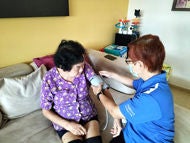What is - Acute Leukaemia
What is acute leukaemia?

Acute leukaemia is a type of cancer of the blood and bone marrow cells. "Acute" indicates that the leukaemia develops and advances quickly and requires immediate medical attention. In patients with acute leukaemia the bone marrow produces an excessive amount of abnormal immature white blood cells which do not function normally. Patient may have low amounts of normal blood cells. There are 2 main types of acute leukaemia, acute myeloid leukaemia and acute lymphoblastic leukaemia.
Symptoms of Acute Leukaemia
What are the symptoms of acute leukaemia?
Symptoms may differ between individuals, depending on the type of leukemia.
Some symptoms are due to the increasing number of abnormal leukaemia cells whereas others are caused by the lack of normal blood cells.
- Tiredness and fatigue
- Fevers and chills
- Bony and joint pains
- Easy bruising of the skin or bleeding
- Swollen lymph nodes (glands)
- Loss of weight and appetite
Acute Leukaemia - How to prevent
How is acute leukaemia prevented?
At present there is no routine screening test for leukaemia.
Individuals should seek medical attention if they have any of the above symptoms.
Currently there are also no proven preventive strategies for leukaemias. However, adopting a healthy lifestyle may help to prevent disease. This includes:
- Eating a diet rich in fruits and vegetables
- Quitting or not starting smoking
- Limiting alcohol consumption
- Regular exercise
Acute Leukaemia - Causes and Risk Factors
What are the risk factors for acute leukaemia?
Most people who develop acute leukemia have no known risk factors and the leukaemia develop spontaneously. There are however some factors which may increase the risk of developing certain types of leukaemia.
These are:
- Previous cancer treatment – chemotherapy and radiation therapy
- Genetic disorders where there are abnormalities in the genes which contribute to the development of leukaemia
- Chemical such as benzene and radiation exposure
Diagnosis of Acute Leukaemia
How is acute leukaemia diagnosed?
The diagnosis of acute leukaemia is usually confirmed after performing a bone marrow test. The sample extracted during the procedure is used to confirm the type of leukemia and define certain characteristics which may guide treatment options.
Treatment for Acute Leukaemia
How is acute leukaemia treated?
The treatment of acute leukaemia depends on the type and characteristics of the disease.
Some treatment options includes:
- Chemotherapy, which are drugs that directly kill leukaemia cells. This may be used in combination with targeted and immunotherapy and can take the form of injection and oral therapy.
Haematopoietic stem cell transplantation may be appropriate for selected patients after initial chemotherapy.
Cellular therapy may be an option for some patients where germ-fighting T cells are re-engineered to fight cancer.
Supportive therapy in the form of blood transfusion, infection prevention and early treatment and management of side effects of treatment is also very important.
In SGH, we have a comprehensive inpatient and outpatient chemotherapy service and offer various options for acute leukaemia treatment.
Contributed by
The information provided is not intended as medical advice. Terms of use. Information provided by SingHealth.
Get to know our doctors at SingHealth Hospitals in Singapore.
Get to know our doctors at SingHealth Hospitals in Singapore. here.




















